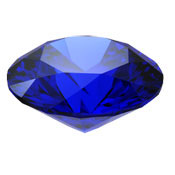Sapphire
(saf-ahyuh r)
HISTORY and LORE
- Linked to royalty throughout history. In Roman times, kings and queens wore sapphires to protect themselves from treachery. The oldest gem in the British Crown Jewels is a sapphire that belonged to King Edward the Confessor (who died in 1066). And when Lady Diana Spencer – the future Princess Di – became engaged to Prince Charles in 1981, she received a ring set with a large blue sapphire.
- Name comes from Greek sappheiros, which was once used for all deep blue gems.
- Traditionally signifies truth, sincerity, and faithfulness. In the Middle Ages, it was thought that wizards used sapphires to control spirits and understand prophecies. Since the 1100s member of the clergy have worn them as symbols of Heaven. For centuries, many people believed owning a sapphire brings blessings.
- Birthstone for September. Gem for the 5th and the 45th wedding anniversaries.
VALUE FACTORS
- Color: Light to dark blue (often greenish or violetish). Most expensive is rich deep blue with a slight tinge of violet.
- Clarity: Often light included. Minor clarity characteristics are accepted.
- Cut: Usually faceted in traditional shapes and styles. Sometimes fashioned into cabochons and beads.
- Carat Weight: Normally available in all jewelry sizes (up to 15 or 20 carats).
TREATMENT
- Almost all blue sapphires are heat treated to improve color or clarity. Another possibility is diffusion treatment, which involves heating pale or “off color” sapphire to very high temperature while it’s in contact with selected chemical coloring agents. Depending on the technique, diffusion produces color in a shallow layer along the gem’s surface, or extending deeper – sometimes all the way through the gem. If penetration isn’t complete, the color can be removed by repolishing or recutting. Otherwise, the effects of both treatments (heat and diffusion) are normally permanent, and they create no special care requirements.
- When a fine-quality blue sapphire is certified as untreated by a respected trade laboratory, it will usually command a premium price.
GEMOLOGY
- A variety of the mineral species corundum. Other corundum varieties are ruby, star ruby, and star sapphire. In the gem trade the term sapphire, when used alone, refers specifically to blue sapphire. All other colors are considered fancy sapphires.
- Composed primarily of aluminum and oxygen; chemical formula Al2O3. Color caused by trace amounts of iron and titanium.
- May display strong pleochroism – greenish blue or violetish blue depending on the viewing direction. This property results from the way the gem crystal interacts with light. Most blue sapphires are oriented to show the violetish color when cut.
CARE
Blue sapphire generally has very good to excellent wearability.
- Hardness: Very high scratch resistance. Rates 9 on the Mohs Hardness Scale. Next to diamond, sapphire and ruby are the hardest natural gems.
- Toughness: Resistance to chipping and breaking is normally excellent.
- Stability: Usually no routine concerns for gem owners.
- Cleaning: Liquid cleaner, or detergent and water. Ultrasonic is usually safe, unless noticeable clarity characteristics are present.
